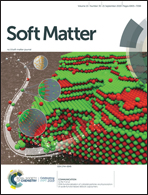Slippery when wet: mobility regimes of confined drops in electrowetting†
Abstract
The motion of confined droplets in immiscible liquid–liquid systems strongly depends on the intrinsic relative wettability of the liquids on the confining solid material and on the typical speed, which can induce the formation of a lubricating layer of the continuous phase. In electrowetting, which routinely makes use of aqueous drops in ambient non-polar fluids that wet the wall material, electric stresses enter the force balance in addition to capillary and viscous forces and confinement effects. Here, we study the mobility of droplets upon electrowetting actuation in a wedge-shaped channel, and the subsequent relaxation when the electrowetting actuation is removed. We find that the droplets display two different mobility regimes: a fast regime, corresponding to gliding on a thin film of the ambient fluid, and a slow regime, where the film is replaced by direct contact between the droplet and the channel walls. Using a combination of experiments and numerical simulations, we show that the cross-over between these regimes arises from the interplay between the small-scale dynamics of the thin film of ambient fluid and the large-scale motion of the droplet. Our results shed light on the complex dynamics of droplets in non-uniform channels driven by electric actuation, and can thus help the rational design of devices based on electrowetting-driven droplet transport.



 Please wait while we load your content...
Please wait while we load your content...